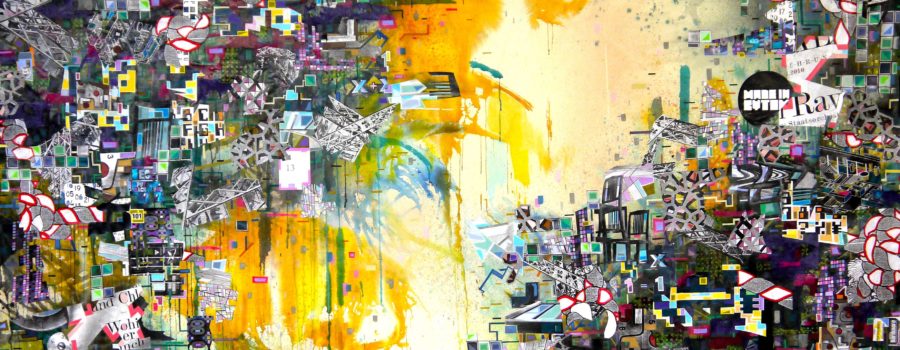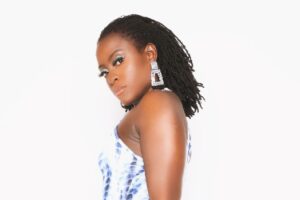“I have always had an affinity for history, detail, and form.” – Eric Mack
A scavenger hunt done to a rhythm. That is what comes to mind whenever I gaze upon a piece from Eric Mack. This Atlanta-based artist’s work is no stranger to movement. To call it stagnant would be a crime. Which is probably why his art will be featured on the debut album of Afriqua. We talked about how that pairing came to be, I Spy, and what’s to come.
Kendra: What medium would you say made you not only want to become an artist but made you feel something when you looked at it as a spectator for the first time?
Eric Mack: The mediums that I feel made me want to become an artist were pencil and charcoal. When I was young, my uncle Reginald was an excellent portrait artist who worked in this medium. The texture and feel of the material captivated me! I can honestly say that I was forever changed when I saw him creating beauty from nothingness. It also made me feel like anything was possible.
My most comfortable medium was pen and ink as I began to create my own works of art. I was also very inspired by calligraphy letters, and fonts around first grade, or so. My mother worked as a librarian at the local technical college in Charleston, South Carolina. The kindergarten I attended was two miles away from her job. When I would get dropped off after school I would spend my free time looking at books about Louis Pasteur, and copying/tracing the decorative fonts from various handwriting manuals since I could not read them.
Kendra: Your work has a lot going on in every piece. There is so much movement with all the patterns and formations. They remind me a lot of those I Spy books that were popular in the ’90s. Do you ever hide little things here and there for people to find?
Eric Mack: The work I create is known to have movement and pattern. Many times when laying down the composition, I insert comedic or simply random bits that I find amusing. When creating the work I always like to entertain myself by doing, and using media or material that I find stimulating. I don’t want to be bored with a piece, and I do not wish for this for the viewer, either.
Viewers seem to appreciate being able to see/find something new in my paintings as they spend time with them. In one of my older works, I have incorporated old high school suspension slip where I had cursed out my Spanish teacher. It makes me laugh every time I see it.
While working on Afriqua’s debut album cover art I utilized this method of working. We were trying to decide how we wanted to incorporate his portrait into the overall composition. I am not really a portrait artist but wanted his true likeness in the work. They mentioned the possibility of using a Where’s Waldo? concept and I thought that would be perfect!
I knew Adam (Afriqua) had a love for krautrock and early German electronic producers such as Popol Vuh, Can, and Kraftwerk. The computer on Kraftwerk’s first album was appropriated by placing Adam’s portrait within the screen of the well-known symbol for the group.

Kendra: You’ve noted that your work also reflects rhythm. With that, if you had to pick a musician to do a performance piece based off one of your pieces, which piece and musician would you pair up?
Eric Mack: If I had to choose a musician to create a performance-based piece on my work it would be Stereolab. I was introduced to their sound in 1994, while in college at The Atlanta College of Art by my friend Dana. When I first heard the album Dots and Loops I was instantly hooked, and began to collect every album that I could find from them!
Their style of layered melodies blended with live instrumentation and Moog synth experimentation was the perfect fuel to power my creative journey. In the mid-2000s, they performed at the Variety Playhouse in Atlanta where I met their manager, Martin. I proceeded to tell him how inspirational the band had been in my artistic production, and I would love the chance to collaborate on artwork for the group.
Three months later, Martin responded by informing me that the band liked my work, but they had been working with one graphic designer for many years and had no plans in changing that. Although, I did not get the chance to work Stereolab I still feel a great deal of happiness that they respected my work as well.
I would pair any work from my “Composites” series to accompany their Dots and Loops album.
Kendra: Speaking of musicians, let’s talk more about this collaboration with Afriqua and the album art for his upcoming September release. How did that come about and did you listen to the whole album and come up with something or did he guide you towards what he was looking for?
Eric Mack: I am very honored and excited to be a part of Afriqua’s musical journey! This all came about by Adam looking for an artist who could translate his sound and represent it in a visual form. His team reached out to me and asked if I was interested in collaborating with Afriqua on his upcoming album cover.
Once I heard what he was creating, I immediately felt a kinship and wanted to be a part of his upcoming project. As we began to throw around ideas about the direction for the cover, he informed me that he wanted to show the unifying power of Black culture through the prism of electronic music.
I asked him to send me his influences, and things that represented him as a person and musician. In turn, I collected vintage southern blues sheet music scores, 80’s Chicago House music club flyers, 70’s German electronic/Krautrock influences, Roland TR-808 schematic diagrams, Gemini horoscope symbols, and native plants from West Africa & of the Southeastern United States that would help form the visual narrative.
I requested his guidance on which direction I should gravitate towards. Once that was established he gave me total artistic freedom to bring the project to life!

Kendra: Afriqua’s noted that as a Black electronic musician from Virginia living in Berlin, he’s challenging a lot in his industry in terms of not only race but locale. Do you feel the same in any way in your art scene?
Eric Mack: I feel that the work I am creating sometimes comes as a surprise to some viewers. As an artist born and raised in the south, there is a bit of a challenge when it comes to overcoming expectations in regards to the type of artwork I make. Over the years, there have heard collectors/viewers tell me “I like your painting…, but do you make black art?”
I have always been amazed by this perspective. The fact that I am black constitutes as black art to me. To many viewers, the work is not black art unless a black person is shown, or cultural symbols are presented.
In the early 2000s, a collector told me one of my paintings reminded him of a noted local artist. That was never my angle, and I did not appreciate it. Ever since that comment was made, I have striven to make work that would never warrant that response, again.
I never wanted to “spoon-feed” the audience with the expected. I always want to inspire the viewer to look closer within my blackness, and all of the influences/experiences that have brought me to this point. I grew up woodworking, skateboarding, barbering, boy scouting, fishing, traveling, building woodland forts, boogie boarding and loving all types of music. These are some influences that go into my artwork creation.
I am still a black artist making black art.
Kendra: Other than working on this album art, can you let the people know what you have coming their way as we head towards the latter half of the year?
Eric Mack: The upcoming year for me is quite exciting! Currently, I’m awaiting the global release of Colored by Afriqua, out October 5th on R&S Record; where I was commissioned to create the original album artwork.
New works are also underway for my 2020 exhibition at Whitespace Gallery in Atlanta, Georgia. The work explores the intersection between sustainable architecture and nature. Over the last two years, I have immersed myself in the world of gardening. I am very happy to share this new body of work with the public. The exhibition will consist of sculptural, and two-dimensional pieces.







